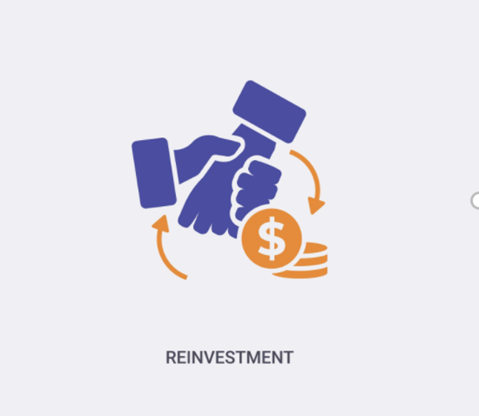What do you mean by Reinvestment Risk?
Reinvestment risk is one of the most common jargons associated with financial risks. The term describes a risk that a particular investment might be cancelled due to some reason and therefore, the investor will have to find a new investment option to reinvest that amount. In addition, it includes a risk that there might not be a similar return available from reinvestment. This primarily happens in the case of bonds.
The reinvestment is made from the interest or dividends earned from a previous investment. Therefore, if there is a drop in the interest rates, it will prevent the investor from earning the same return on reinvestment as the original bonds.
Summary
- Reinvestment risk describes a risk that a particular investment might be cancelled due to some reason, and therefore, the investor will have to find a new investment option to reinvest.
- The investor might not get the return from reinvestment.
- Zero-coupon bonds do not have any inherent investment risk.
Frequently Asked Questions
Is it true that Reinvestment Risk means a lower rate of returns for an investor?
The reinvestment is made from the interest or dividends earned from a previous investment. The risk before an investor is that if the said amount is reinvested, it will not generate the same rate to return which the earlier investment had generated. Reinvestment risk is the probability that an investor will have to reinvest his money into an investment from an existing investment where the interest rates are lower than the current rate. In short, this means that there are chances that this reinvestment will provide him with lower returns. It should be noted that pension funds are vulnerable to reinvestment risks. Besides, callable bonds are also subject to reinvestment risks because these bonds are redeemable, and as such, the bond issuer can repurchase these bonds when the interest rates are low.

Image Source: © Rahimovarufana | Megapixl.com
Can you give an example of Reinvestment Risk associated with Callable Bond?
Suppose an XYZ firm has issued a callable bond at a coupon rate of 8% and with the condition that the bond will be not called off, which means the issuer will not repurchase this bond before the completion of a year. After a year, there is a drop in the interest rates, and as such, the interest rate reaches 3%. As the interest rate falls, the investor buys back the bond to refinance its debt at a reduced rate. The investor does this because if the same bond is sold at the reduced interest rates, this will ultimately add to the gains made by the investor. Till that time, the investor would have received the 8% coupon for one year and the principal amount in addition to the agreed call premium. In this situation, the investor will be vulnerable to the reinvestment risk when this cash flow would be reinvested at 3% rather than the earlier 8%.
What are the disadvantages of Reinvestment Risk?
- In a reinvestment risk, the realized yield is lower than the expected rate of return.
- Certain bonds or investments are classified as risk-free. However, this is not true because nothing is certain in real life, and no one is immune to the investment risks.
- Investors who are more inclined towards short term bonds are often the victims of the reinvestment risks.
What are the different ways to manage Reinvestment Risk?

Image Source: © Iqoncept | Megapixl.com
- Prefer zero-coupon bonds – Zero-coupon bonds does not make periodic interest payments. There is less risk involved in the zero-coupon bonds because here, the investors only have to think about investing the maturity value or the face value, for that matter. Zero-coupon bonds are sold at a reduced price because of the deep discounts on their face value. The duration of zero-coupon bonds is equal to the bond’s time to maturity. This is the reason why these bonds are more sensitive to any changes in the interest rates.
- Investing in Non-callable Bonds – Investing in non-callable bonds is another known method to mitigate reinvestment risk. These bonds are also referred to as non-redeemable because their issuer cannot call them until their maturities or penalties are paid to the bondholder. Till this time, Non-callable Bonds continue to pay a coupon to the investor.
- Portfolio diversification – Another way to reduce reinvestment risk is portfolio diversification, which means holding a diversified portfolio with a mix of different investments. If an investment is made into different portfolios, there are significantly fewer chances that all the investments will perform poorly at the same time. The profits can offset the losses in one security that performed poorly in the other. Bonds and stocks often move in opposite directions.
- Preferring investment in those bonds or securities where proceeds from that bond are reinvested in the same bond.
- Hiring fund managers with a good professional record.
- Reinvestment into coupon payments – Yet another standard method to mitigate reinvestment risk is reinvestment into coupon payments. Instead of making coupon payments to the investor, some bonds automatically reinvest the coupon paid back into the bond, growing at a stated compound interest rate. If the maturity period of these bonds is long, then this compound interest results in a higher rate of returns for the investors. Subsequently, reinvested coupon payments are likely to constitute around 80% of the returns on a bond. The exact amount primarily depends on the earnings made via the interest rate on reinvested payments and the maturity period of a bond.
What are factors that affect the quantum of Reinvestment Risk in a bond?
The two factors which affect the quantum of Reinvestment Risk in a bond are:
- Maturity of the bond – The longer the bond's maturity, the higher the probability that the interest rates will be lowered as compared to what they were at the time of the purchase of the bond initially. This means that the reinvestment risk will be more for a bond with higher maturity.
- Bonds Interest / Coupon Rate – There will be a higher reinvestment risk for a bond with a higher interest rates and coupon payments. Therefore, it is advisable to invest in Zero-coupon bonds to minimise the reinvestment risk because they do not make periodic interest payments.
 Please wait processing your request...
Please wait processing your request...